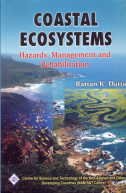Coastal Ecosystems: Hazards Management and Rehabilitation/NAM S&T Centre
Coastal Ecosystems: Hazards Management and Rehabilitation/NAM S&T Centre
Couldn't load pickup availability
Coastal zones contain many of the Earth's most complex and diverse ecological systems, productive in both the biological and economic senses. Coastal region includes inshore waters, inter-tidal areas and extensive tracts of contiguous land. Coastal zones are not only economically valuable for fisheries, commerce, navigation and recreation, but also include some of the most ecologically important environments. Regrettably, these economic, social, and environmental benefits are at a risk as the coastal zones are affected by both gradual and recurrent processes such as accretion and erosion and by extreme natural events such as floods, hurricanes, typhoons, tsunamis, earthquakes and severe storms. This is further aggravated due to increased economic activity within the coastal zones resulting in costly damages to property, society, economy and environment. This combination of natural and human forces and the uncertainties involved in their origins and impacts presents major challenges to coastal managers. In order to address some of the above issues, the NAM S&T Centre organized an international workshop-cum-training course on 'Coastal Ecosystem: Hazards Management and Rehabilitation' at Purwokerto, Indonesia during 8-17 August 2006 and brought out this publication which includes a collection of 26 selected research/review papers on various aspects of Coastal Ecosystems.
Share

